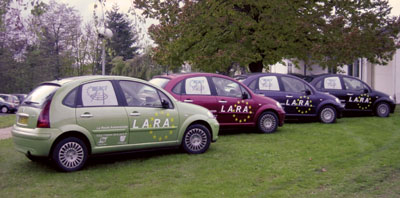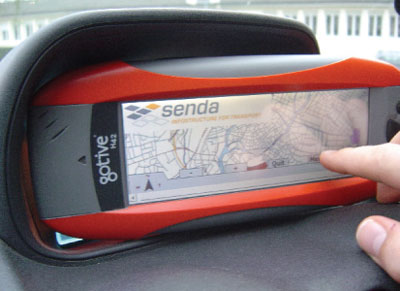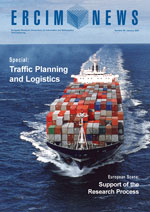by Arnaud de La Fortelle, Angel Talamona and Mikaël Kais
The research collaboration LaRA (La Route Automatisé) between the IMARA (Informatics, Mathematics and Automation for La Route Automatisée) Lab at INRIA and the 'Centre de CAO et Robotique' CAOR at the Ecoles de Mines de Paris, improves the state of the art of traffic prediction technology through statistical modelling based on instrumented probe vehicles. Working together with European industrial and research partners like TNO, Motorola and Intempora, the European project REACT (Realizing Enhanced Safety and Efficiency in European Road Transport) has demonstrated breakthrough technology based on integrated in-car sensing and a traffic management centre. SENDA, an INRIA spin-off company that is licensing LaRA's traffic modelling technology, has built on the work of REACT to overcome technical issues for the cooperative system's deployment.
The goal of cooperative systems like REACT is to increase the efficiency of European road transport by providing drivers with up-to-date information on road conditions. For this, vehicles sense real-time natural and infrastructure conditions both within themselves and in their vicinity, and transmit these data to a central server. There they are aggregated and analysed by an integrated set of models to generate both vehicle-specific recommendations and information for relevant authorities.
Analysing Traffic with Probe Vehicles to Generate Customized Road Advice
The analysis of the traffic conditions and safety risks of different routes can only be performed by a central server, which collects and analyses data coming from a large number of geographically distributed vehicles. REACT has key advantages over current systems, including:
-
mobile rather than stationary sensors, covering all routes where vehicles travel
-
measurement of relevant natural and infrastructure conditions
-
customized, model-based recommendations transmitted to individual vehicles.
The REACT technology has been integrated into a fleet of instrumented cars, used by LaRA for cooperative vehicle technology research (see Figure 1).

Technology Transfer Issues
While a proof of concept might be enough to validate research activities, actual innovation, in the sense of the economic exploitation of new technology, needs to go further. There are three main lessons to be learnt from the REACT project. First, a large number of players is necessary to put in place a running cooperative system based on probe vehicles (eg public road operators, software companies, equipment providers), and the aims and motives of these parties may not be the same. Second, the integration and successful communication of a 'proof of concept' initiative is an excellent tool for making these concepts comprehensible and encouraging stakeholders to reach operational solutions. Third, a relatively high threshold of deployment is necessary (3-5 % of vehicles in the entire road network must be equipped) to make traffic technology based on probe vehicles exploitable.
SENDA's Alternative, Internet Personal Navigation Device for Collaborative Navigation
SENDA is a mobility-oriented software company and a spin-off from INRIA. It licenses LaRA's statistical model for traffic prediction based on probe vehicles, which was developed during the research project REACT. Combining the technical constraints for the deployment of such breakthrough technology with the need to reduce the number of players in the value chain, SENDA conceived an alternative approach: a collaborative GPS navigation device.
This high-end navigation device corresponds to European drivers' demands for improved route guidance, based on better-quality road traffic information and higher coverage of the road network. The principle is simple: the GPS navigator is supplied with an embedded wireless Internet interface and the ability to act as a mobile traffic sensor. The navigator's position and speed are anonymously transmitted to a central management server that statistically processes this information and then consolidates it with the data coming from the road operator's traffic information centre
This concept for innovative navigation is derived from INRIA's previous work in the European projects Cybercars and Ozone, and from the SENDA prescriptive navigation. The latter was a finalist in the European Commission's GST Service Submission Contest. SENDA's first collaborative navigator prototype was introduced during the ITS World Conference 2006. Commercial vehicle renting companies are already interested in such an approach and are discussing with SENDA the implementation of high-end GPS navigation pilot devices for professional drivers.

SENDA has exploited LaRA's research to produce innovations in traffic prediction technology for the next generation of traffic management systems. The REACT experiments helped SENDA move ahead on their reflections, and synthesize a convenient product targeting an emerging market. Deployment of traffic prediction solutions by SENDA will provide valuable real-world feedback to LaRA's research, which in turn will lead to improvements in and testing of predictive models.
Link:
http://www.react-project.org/
Please contact:
Arnaud de La Fortelle
Ecole des Mines de Paris, France
E-mail: arnaud.de_la_fortelle![]() ensmp.fr
ensmp.fr
Angel Talamona, Mikaël Kais
SENDA, France
E-mail: Angel.Talamona![]() senda-online.com, Mikael.Kais
senda-online.com, Mikael.Kais![]() senda-online.com
senda-online.com










